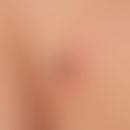Synonym(s)
DefinitionThis section has been translated automatically.
According to the definition made at the "Second International Symposium on Lyme Disease and Related Disorders" in Vienna in 1985, "Lyme borreliosis" includes all clinical manifestations in humans caused by infections with B. burgdorferi sensu lato (see Borrelia below). Accordingly, Lyme borreliosis in humans is a multisystemic spirochetosis that can progress both as a mild local infection and as a staged, chronic multisystem spirochetosis. Lyme borreliosis is the most common infectious disease transmitted by ticks. The pathogen is transmitted by shield ticks(Ixodes ricinus, the common wood tick).
PathogenThis section has been translated automatically.
Borrelia burgdorferi (see Borrelia below): filamentous, coiled, motile spirochete. Carriers are ticks (Ixodes ricinus, I. dammini, etc.), which are ubiquitous in Central, Eastern and Northern Europe and America, rarely also insects, e.g. Stomoxys calcitrans. Hyalomma ticks (giant ticks) do not transmit borrelia.
About 5-35% of ticks are infected with Borrelia, whereby adult ticks are infected to about 20%, nymphs to 10% and larvae to about 1%. Diaplacental infection is possible. After being bitten by an infected tick, the risk of transmission is approx. 5%, the risk of disease approx. 1%.
To date, 5 pathogenic species of B. burgdorferi have been described in Europe:
- B. burgdorferi sensu lato
- B. afzelii
- B. garinii
- B. bavariensis
- B. spielmanii
In Europe, it is mainly Borrelia burgdorferi sensu lato that is transmitted. In the USA, only B. burgdorferi sensu stricto is observed.
All species can cause erythema migrans. B. garinii and B. bavariensis show an association with neurological manifestations, B. afzelii with the development of acrodermatitis chronica atrophicans, and B. burgdorferi sensu stricto is associated with Lyme arthritis.
You might also be interested in
Occurrence/EpidemiologyThis section has been translated automatically.
The most common tick-borne disease in Europe and North America. About 5-35% of ticks are infected with Borrelia. All 3 groups of borrelia are found in Europe. Also on the west and east coasts of the USA. Borrelia infections also occur in China.
Incidence: There are only rough estimates of the incidence of Lyme borreliosis in humans in Germany, as only a few federal states (Berlin, Brandenburg, Mecklenburg-Western Pomerania, Rhineland-Palatinate, Saarland, Saxony, Saxony-Anhalt, Thuringia) have a mandatory reporting requirement. Manifestations of Lyme borreliosis that must be reported are erythema migrans, early neuroborreliosis and acute Lyme arthritis. In 2009, the annual incidence in the new federal states was 34.7 reported cases per 100,000 inhabitants. The results of two population-based prospective cohort studies in southern Germany showed annual incidences of between 111 and 260 cases per 100,000 inhabitants. The number of new cases per year in Germany is estimated at 50,000 to 100,000. Based on health insurance data, one study estimated that 214,000 patients are diagnosed with Lyme disease in Germany each year. Regardless of the exact number of new cases per year, it is undisputed that Lyme borreliosis is a widespread disease that must be taken seriously.
On average, 20% of adult ticks are infected with Borrelia, 10% of nymphs and only around 1% of larvae.
After a tick bite, an infection (seroconversion) can be expected in 1.5-6% of those affected and a manifest disease in 0.3-1.5%.
Risk of infection: The risk of infection is highly dependent on weather conditions. The shield tick species Ixodes ricinus is active from a temperature of about 6°C. Diseases of erythema migrans occur more frequently in June and July, diseases of neuroborreliosis in July and August, while Lyme arthritis is diagnosed all year round due to the variable incubation period.
ManifestationThis section has been translated automatically.
All age groups are affected.
ClinicThis section has been translated automatically.
Classification into 3 stages, whereby each stage can represent the first manifestation of the disease and stages can be skipped (see Table 1):
-
Stage I (localized early infection):
- The main symptom is erythema migrans. May be accompanied by: regional swelling of the lymph nodes, mild general symptoms (fever, fatigue, headache). Borrelia serology is usually negative at this stage of the disease. The clinical findings are diagnostic. Even without antibiotic therapy, the erythema migrans usually improves within weeks or disappears completely.
-
Stage II (disseminated early infection; 6-8 weeks after the tick bite):
- B. afzelii does not spread as frequently as B. burgdorferi, but may also persist for months or years at skin sites, either at the site of the previous tick bite or at other sites, whereas B. garinii is particularly neurotropic. Clinically characteristic are unspecific exanthema (also multiple erythema migrans), cheek erythema, erythema nodosum, arthralgias, myalgias, myo-/pericarditis, recurrent hepatitis, conjunctivitis, possibly panophthalmitis, swelling of lymph nodes and spleen. Possibly severe feeling of illness.
- A rare skin manifestation of early Lyme borreliosis in Europe is the borrelial lymphocytoma, which is typically found on the earlobe in children and on the nipple in adults and is usually caused by a B. afzelii infection (Mullegger RR 2004). See below lymphadenosis cutis benigna (lymphocytoma).
- Carditis: AV block I0-III0- perimyocarditis.
- Early neuroborreliosis: lymphocytic menignitis (especially in children) or Garin-Bujadoux-Bannwarth meningoradiculitis (severe nocturnal headaches, mild neck stiffness, cranial neuropathy (especially facial paralysis) or unilateral radiculitis with painful paralysis, possibly discrete encephalitis. In other patients, the clinical symptoms of CNS involvement can often be vague and consist mainly of headache, dizziness, concentration and memory disorders and paresthesias.
- The (rare) multiple occurrence of "erythema chronicum migrans" should be seen as a cutaneous sign of early dissemination of the Borrelia infection. More common in the context of disseminated early infection are large, homogeneously bright red, sharply defined, less symptomatic circular or oval erythema; they are often only discreetly perceptible or only visible when warm. In children, the face is usually also affected (differential diagnosis!).
-
Stage III (late infection with organ manifestation):
- The leading clinical dermatologic symptom of stage III in Europe is acrodermatitis chronica atrophicans (for clinic and differential diagnosis see there). Stage III is always accompanied by a positive Borrelia serology. A negative serologic result excludes the disease!
- Nodular panniculitis (rare) is observed as a hyperergic reaction to a Borrelia infection.
- Lyme arthritis is characterized by a typical joint pattern with mono- or oligoarthritis. In Europe, it occurs less frequently and earlier in the course of the disease than in the USA. The average time from erythema migrans to the onset of arthritis is 3 months (range: 10 days to 16 months).
- Late neuroborrliosis: In Europe, neurological symptoms with asymmetrical paresis of the extremities and cranial nerve deficits may occur in stage III (often facial nerve palsy / 30% of cases possibly abducens palsy).
- Nodular panniculitis (rare) as a hyperergic reaction to a Borrelia infection.
- A double infection with the tick-borne encephalitis virus is very rare. The clinical sign is the picture of "progressive encephalomyelitis", similar to encephalomyelitis disseminata (multiple sclerosis).
- Post-infectious Lyme borreliosis syndrome (post Lyme syndrome): Even after healing of the borrelia-typical HV through sufficient antibiotic therapy, a general feeling of illness with muscle and joint pain can persist for months in an undefined minority of patients. A proposed definition for this syndrome is the presence of subjective symptoms that begin within six months of the diagnosis and treatment of an objective clinical manifestation of Lyme borreliosis and persist for at least six months (Wormser GP et al. 2006).
- Remember. Lyme borreliosis does not have to go through every stage, but can skip a stage or only become clinically manifest with stage II or III!
- Not infrequently, clinically silent infections are also possible!
LaboratoryThis section has been translated automatically.
Antibodies can be detected in 50% of patients in the first 2 weeks after infection and in 80% of patients after > 4 weeks. Serological parameters cannot be used to differentiate between an active and a past infection (antibodies remain for months to years even after an adequately treated infection).
The guidelines of the microbiological quality standards (MiQ = acronym for "quality standards in microbiological-infectiological diagnostics") recommend the detection of separate IgG and IgM antibodies using a sensitive ELISA and, if positive, an analysis with a specific immunoblot.
Due to the diagnostic gap of 2-5 weeks for IgM and 2-3 months for IgG, Borrelia antigens can be detected by PCR from infected skin material.
Experimental: attempt to culture the pathogen from bioptic material (Barbour-Stoenner-Kelly medium in a microaerophilic environment at a temperature of 33 °C).
| IgM western blot | positive if 1 or more bands of: p17, OspC, p39,p41 are detected |
| IgG western blot |
positive on detection of 2 or more bands of: p14, p17, OspC, p30, p39, p43, p58, p83/100 and detection of 1 or more bands of: dpbA (osp17), p17b, p21, OspC, p58, p30, p39, p43, p83/100 (Pbi, Borrelia garinii) |
The findings are interpreted against the background that the prevalence of antibodies in the normal population is around 1% in young children and >25% in people >60 years of age. The main limitation of serological tests is that IgG and even IgM antibodies against B. burgdorferi may still be present months or years after the spirochetes have been almost or completely eliminated by antibiotics. The amount of antibodies slowly decreases after treatment, but the results of the Western blot, a non-quantitative test, do not change significantly in the period after antibiotic treatment. Therefore, serologic tests cannot be used to determine active infection or the appropriateness of antibiotic therapy. In addition, B. burgdorferi can cause asymptomatic infections in ~10% of patients in the United States. In a study of seroprevalence in Sweden, >50% of individuals who were seropositive for B. burgdorferi by ELISA did not recall ever having symptoms of Lyme borreliosis (Steere AC et al. 2003).
Neuroborreliosis: The determination of the CSF serum index is of great diagnostic value for the detection of neuroborreliosis. This determines whether antibodies (intrathecally formed AK) against Borrelia are produced in the CSF. In conjunction with a lymphocytic pleocytosis (usually the leukocyte count is < 1000/ul, with significant lymphocytosis), protein elevation (1 g/l and more) and barrier disorder, the diagnosis can be confirmed in most cases. Sometimes AK is already found when the serum antibody test is still negative or still in the borderline range.
HistologyThis section has been translated automatically.
DiagnosisThis section has been translated automatically.
The clinical-dermatological picture is diagnostic for many cases.
Also important: medical history (often positive for tick bite ).
Proof of infection by positive Borrelia serology. In the case of Borrelia, cross-reaction with Treponema pallidium (TPHA test).
Neuroborreliosis: CSF diagnostics - Borrelia-specific antibody index (CSF/serum dinex) for IgG and IgM, lymphocytic pleocytosis, protein, CACL13 if necessary.
If necessary, biopsy with detection of the Borrelia antigen using PCR.
Differential diagnosisThis section has been translated automatically.
Early infection:
- for DD of erythema chronicum migrans see there
- for DD of lymphadenosis cutis benigna (borrelia lymphocytoma) (see there)
Disseminated early infection:
- Erythema anulare centrifugum: Multiple, partly anular, partly also polycyclic, slowly centrifugally growing, typically surface-smooth, little or no itching plaques. Almost pathognomonic is the palpation finding (resembles a wet woolen thread): with a rough border. Histology is often characteristic. Positive serology is to be expected in this phase of Lyme borreliosis.
- Medicinal exanthema, maculo-papular: To exclude Lyme borreliosis, serologic evidence of Borrelia infection can always be obtained in this phase of infection.
- In case of facial erythema/children: Erythema infectiosum: Acute clinical picture with butterfly-shaped redness and swelling of the cheeks (in 75% of patients: slapped cheeck appearance).
Late infection of the skin
- for DD of acrodermatitis chronica atrophicans ( see there)
Complication(s)(associated diseasesThis section has been translated automatically.
Development of cutaneous B-cell lymphomas has been described in isolated cases (see: Primary cutaneous marginal zone lymphoma).
TherapyThis section has been translated automatically.
Stage I:
- In case of localized early infection(erythema chronicum migrans) oral doxycycline therapy (2x100mg/day p.o. or 200mg 1x/day p.o.) for 14 days. A higher dosage is not necessary.
- Alternative: Amoxicillin (e.g. Amoxicillin ratiopharm) 3 times/day 500 (-750) mg p.o. for 14 days
- Alternative: Cefuroxime (e.g. Cefuhexal) 2 times/day 500 mg p.o. for 14 days.
- Alternatively: Azithromycin 2x250mg p.o. for 10 days.
- Children:
- Amoxicillin 50 mg/kg bw/day p.o. divided into 3 daily doses over 14 days
- Alternatively: Cefuroxime (e.g. Cefuhexal) 20-30 mg/kg bw p.o. divided into 2 daily doses over 14 days.
- From the age of 9 years Doxycycline (e.g. Doxycycline AL) 2 times/day 100 mg p.o. or 4 mg/kg bw/day for 14 days. Doxycycline is contraindicated in children <8 years.
Stage II:
- Doxycycline 1 time/day 200 mg p.o. over 21 days
- Alternative: Amoxicillin 3 times/day 750 mg p.o. over 21 days
- Alternative: Cefuroxime 2x500mg over 21 days
- Alternative: Ceftriaxone (e.g. Rocephin, Ceftriaxon® ratiopharm) 1 time/day 2 g i.v. for 21 days.
- Lighter manifestations of stage II should be treated orally for 2 weeks, this also applies to children.
-
Infestation of the central nervous system:
- Systemic application of cephalosporins such as ceftriaxone, e.g. Rocephin® 1 time/day 2 g i.v. over 21 days, is to be preferred in all cases. The antibiotic cycles should be repeated at 3-month intervals depending on the clinical situation and should last at least 14 days due to the generation times of the borrelia.
- Children:
- Ceftriaxone (e.g. Rocephin, Ceftriaxone ratiopharm) 50-100 mg/kg bw/day i.v. for 14 days.
- Alternatively: Cefotaxime 200 mg/kg bw/day, max. 3 times/day 2 g i.v. over 14 days (see above regarding repeated therapy). Benzylpenicillin 500,000 IU/kg bw/day, max. 10 million IU/day, 4-6 ED i.v. over days.
- From age > 9 years: Doxycycline (e.g. Doxycycline AL) 2 times/day 100 mg p.o. or 4 mg/kg bw/day for 14 days.
- Children:
- Systemic application of cephalosporins such as ceftriaxone, e.g. Rocephin® 1 time/day 2 g i.v. over 21 days, is to be preferred in all cases. The antibiotic cycles should be repeated at 3-month intervals depending on the clinical situation and should last at least 14 days due to the generation times of the borrelia.
Stage III (The duration of a treatment cycle should be 3 to a maximum of 4 weeks. Acrodermatitis chronica atrophicans and borrelial arthritis can be treated primarily with an oral antibiotic):
- Doxycycline 1 time/day 200 mg p.o. for 21 days
- Alternatively: Amoxicillin 3 times/day 750 mg p.o. for 21 days.
- Alternative: In case of insufficient clinical response, relapses or complete treatment failure, switch to i.v. treatment, e.g. ceftriaxone 1 time/day 2 g i.v. (alternative: cefotaxime 3 times/day 2 g i.v.) for 21 days or penicillin G 4 times/day 5 mega i.v. for 21 days.
- Borrelia carditis: Analogous to clinical stage II.
- Borrelia arthritis: Analogous to clinical stage II.
-
Note! Acrodermatitis chronica atrophicans: The activity of the process should be checked clinically and histologically! Antibody titer controls are not very informative for the course of the healing process, therefore it is better to use a Borrelia PCR. Skin atrophies are only reversible to a limited extent.
- In children and during pregnancy:
- Amoxicillin (e.g. Amoxicillin ratiopharm®) 50 mg/kg bw/day p.o. in 3 ED
- Alternatively: Ceftriaxone (e.g. Rocephin®) 20-80 mg/kg bw/day i.v.
- Alternative: Erythromycin (e.g. Erythro-Hefa® juice) 3 times/day 100-500 mg p.o.
- Alternatively: Clarithromycin (e.g. Klacid®) 15 mg/day/kg bw for 7-10 days.
- In children and during pregnancy:
In immunosuppressed patients: Therapy recommendations in the individual stages remain unchanged.
Pregnancy:
- In erythema chronicum migrans: amoxicillin (3 times/day 500 mg p.o. over 2-3 weeks), if strictly indicated cefuroxime 2 times/day 500 mg p.o. over 2-3 weeks); in case of beta-lactam allergy azithromycin (2 times/day 250 mg p.o. over 2-5 days) is recommended. Penicillin V is also an alternative.
Post-infectious Lyme borreliosis syndrome (post Lyme disease):
- These post-infectious "rheumatoid" symptoms are treated consistently with antiphlogistics.
Progression/forecastThis section has been translated automatically.
Favorable. Most symptoms are self-limiting. Different course of the disease in Europe and North America. Spontaneous healing in stage 1 (erythema chronicum migrans as the sole symptom) is much more common in Europe than in the USA, where organ involvement is more common. The typical manifestation of stage 3 of the disease in Europe is acrodermatitis chronica atrophicans, in North America Lyme arthritis.
It is not uncommon for patients to complain of a general feeling of weakness and sickness with muscle and joint pain for months after the Borrelia-typical skin lesions have healed following antibiotic treatment. These unspecific symptoms are referred to as post Lyme syndrome (post-treatment Lyme disease syndrome). The term "chronic Lyme disease" for this clinical picture is misleading! There is no evidence of pathogen persistence. Antibiotic therapy is not necessary. Instead, long-term antiphlogistic therapy.
ProphylaxisThis section has been translated automatically.
Repellents: In mild weather, avoid undergrowth and tall grass, wear closed, light-colored clothing and sturdy shoes. Tuck trouser legs into socks. Rub repellents into legs and arms (effective for up to 4 hours). Inspect entire body after exposure.
Early removal of the tick: In case of tick bite with tick still present: Remove the tick, use thin, firm tweezers, grasp the tick as close as possible to the biting tools and pull it out. The tick's body should not be squeezed or covered with oil or glue in order to avoid increased secretion of saliva containing the pathogen. The earlier the tick is removed, the lower the probability of pathogen transmission (from 12 hours after the bite).
Oral antibiotics: The opinions of the various professional associations differ with regard to prophylactic administration after a tick bite. For example, the current guidelines of the French scientific society reject the initiation of antibiotic therapy. In contrast, the US professional societies of rheumatologists, neurologists and infectiologists (2020) recommend a single dose of doxycycline after a tick bite. In a meta-analysis with 376 patients, a risk ratio (relative risk=RR) was calculated for the rates of unfavorable events (e.g. Lyme borreliosis or erythema migrans) in patients who received an intervention compared to the respective control group with antibiotic-free standard therapy. In the group with oral antibiotics, 0.2% suffered an unfavorable event, in the control group it was 2.5%. In the subgroup of patients who received an antibiotic for ten days, there were no unfavorable events, compared with 1.3% in the control group. When only the patients who received a single dose of 200mg doxycycline were compared with fecal rolls, the pooled event rate was 0.8% vs. control with 3.0 % . The consequence of this analysis is the recommendation of a single dose of 200mg doxycycline p.o. after a tick bite. (Zhou G et al. 2021)
Local antibiosis: A 10% azithromycin gel applied to the bite site several times every 12 hours at least 3 days after the bite can prevent infection. In a larger study, however, a significance for clinical efficacy could not be established (Schwameis M et al. 2016).
TBE: Vaccination during a stay (e.g. vacation) in endemic areas.
TablesThis section has been translated automatically.
Stages and clinical manifestations of Lyme borreliosis
Stadium |
Incubation period |
Skin |
Nervous System |
Organ Systems |
Locomotor system |
General symptoms |
I |
days - weeks |
Erythema chronicum migrans, ring-shaped erythema |
Meningism |
Splenomegaly, Hepatosplenomegaly |
Myalgias, Arthralgias |
swelling of lymph nodes, fever |
II |
weeks - months |
Maculo-papular exanthema, lymphocytoma, diffuse erythema |
Meningitis, neuritis, radiculitis |
myopericarditis, AV block, pancarditis, eye involvement, hepatitis, microproteinuria, microhaematuria, respiratory tract infections |
Arthritis, myalgia, myositis, migratory pain in the musculoskeletal system, osteomyelitis, panniculitis |
Severe feeling of illness, swelling of lymph nodes |
III |
months - years |
Acrodermatitischronica |
Chronic encephalomyelitis, spastic parapareses, ataxic gait, mental disorders |
Chronic arthritis, periostitis, arthropathy |
Lassitude |
Note(s)This section has been translated automatically.
- The risk of infection after a tick bite can be assessed more accurately by testing the tick for B. burgdorferi (PCR diagnostics). Prophylactic administration of antibiotics in a given case can prevent disease and save the healthcare system considerable costs.
- It is being discussed whether an infection with Borrelia burgdorferi plays a pathogenetic role in atrophodermia idiopathica et progressiva. In a study with 17 test subjects, IgG antibodies against Borrelia burgdorferi were detected in 53%.
- After an infection and adequate antibiotic treatment for Lyme disease, non-specific symptoms such as reduced performance, fatigue and impaired concentration are often reported. This symptom complex is described as post-Lyme syndrome. Whether a new antibiotic therapy cycle should then take place is currently still unclear.
- Infection inDoxycycline during pregnancy: In some larger epidemiological studies (35,000 pregnant women; 1500 infants and children) no increased risk of malformations, prematurity, fruit death could be demonstrated.
- Long-term administration of ceftriaxone poses a risk of pseudomembranous colitis caused by Clostridium difficile.
- Immunity: A Borrelia infection does not leave any lasting immunity. Reinfections are possible!
- Efficacies: In a meta-analytical review (19 studies with 2532 patients), no differences in efficacy were found between the individual antibiotics listed here: amoxicillin, doxycycline, cefurroxime axetil, ceftriaxone, azithromycin, phenoxymethylpenicillin, minocycline. There were also no significant differences with regard to the side effect profile (Torbahn G et al. 2018).
- Costs: The estimated average costs of Lyme borreliosis in a larger Belgian collective were €193 per patient for early Lyme borreliosis and €148 per patient for disseminated/late LB. Patients with early Lyme borreliosis therefore cost 26 times less than patients with chronic Lyme borreliosis. However, the latter also occurs 16 times more frequently than disseminated/late Lyme borreliosis. Compared to other infectious diseases, the cost burden remains limited due to the relatively low incidence (Geebelen L et al. 2022).
Case report(s)This section has been translated automatically.
Lyme borreliosis as an occupational disease(BK 3102)
The general practitioner Dr. S. informed the defendant (Berufsgenossenschaft für Gesundheitsdienst und Wohlfahrtspflege) that the plaintiff (53-year-old long-time forestry worker) was suffering from the consequences of Lyme disease, which he had most likely contracted from a tick bite during forestry work. He also suffers from severe back pain, which can be attributed to a considerable degeneration of the lumbar spine. No neurological pathology was found. At the end of February, a positive borrelia serology (IgM western blot: negative; IgG western blot: detection of several bands) was diagnosed. The test result was well compatible with a late stage of Lyme borreliosis. The plaintiff had no recollection of tick bites. Despite antibiotic treatment, there was no improvement; further treatment had to be discontinued due to a massive allergy. Neurologically, no clear evidence of Lyme disease or radicular damage could be found. An occupational physician stated that the plaintiff had been engaged in forestry and woodland work. The occupational requirements for BK 3102 were therefore likely to be met. The serological findings confirmed an infection with Borrelia burgdorferi, but did not allow any statement to be made about the stage of the disease.
Epidemiological data showed that one in five ticks (20%) in the home region is infected with Borrelia burgdorferi (Note: The degree of infestation varies from region to region in Germany, but is not unusually high. In relation to the whole of Germany, about 5-35% of ticks are infected with Borrelia, with adult ticks being infected to about 20%, nymphs to 10% and larvae to about 1%. After being bitten by an infected tick, the risk of transmission is approx. 5%, the risk of disease approx. 1%).
The recognition of an occupational disease and the granting of compensation benefits were rejected by the defendant BG. The causal connection between the disease and the occupational activity was possible, but not sufficiently probable. The existence of a borrelia-related illness was possible, but not proven. Furthermore, recognition as an occupational disease under No. 3102 "presupposes a special risk of infection that goes beyond the normal level. Such an increased risk did not exist in the plaintiff's area of work. Nor did the claimant himself remember a tick bite. This makes a connection between the occupational activity and the disease a mere presumption. A tick bite during private leisure time is equally possible.
The judgement: In its judgement, the SG ordered the defendant BG to recognize the plaintiff's Lyme disease as an occupational disease no. 3102 of the Annex to the BKV and to grant the statutory compensation benefits. The claimant was almost certainly suffering from Lyme borreliosis. It was at least probable that there was a causal connection between the plaintiff's work (working in the construction of forest and logging roads) and Lyme borreliosis. The plaintiff had been exposed to an increased risk of infection. The evidence of an increased risk of infection allows the conclusion that the plaintiff contracted the communicable disease through his particular occupational exposure. There were no concrete indications that the disease was caused by non-occupational influences.
LiteratureThis section has been translated automatically.
- Aberer E et al. (1988) Neuroborreliosis in morphea and lichen sclerosus et atrophicus. J Am Acad Dermatol 19: 820-825
- Bransfield R, Brand S, Sherr V (2001) Treatment of patients with persistent symptoms and a history of Lyme disease. N Engl J Med 345: 1424-1425
- Duray PH (1987). The surgical pathology of human Lyme disease. An enlarging picture. Am J Surg Pathol 11(Suppl. 1):47-60.
- Duray PH (1989) Histopathology of clinical phases of human Lyme disease. Rheum Dis Clin North Am 15:691-710 [PubMed] [Google Scholar]
- Furst B et al (2006) The impact of immunosuppression on erythema migrans. A retrospective study of clinical presentation, response to treatment and production of Borrelia antibodies in 33 patients. Clin Exp Dermatol 31: 509-514
- Geebelen L et al. (2022) Lyme borreliosis in Belgium: a cost-of-illness analysis. BMC Public Health. 22:2194
- Hofmann H (2012) Variability of cutaneous Lyme borreliosis. Dermatology 63: 381-389
Høiberg HK et al. (2021) Acrodermatitis chronica atrophicans in prolonged borrelia infection. Tidsskr Nor Laegeforen 141 (16)
- Kern A (2011) Tick salvia represses innate immunity and cutaneous inflammation in a murine model of lyme disease. Vector Borne Zooonotic Dis 11: 1343-1350
- Kinjo Y et al.(2006) Natural killer T cells recognize diacylglycerol antigens from pathogenic bacteria. Nat Immunol 7:978-986.
- Lazarus JJ et al. (2006) IL-10 deficiency promotes increased Borrelia burgdorferi clearance predominantly through enhanced innate immune responses. J Immunol 177:7076-7085.
- Logiudice K et al. (2003) The ecology of infectious disease: effects of host diversity and community composition on Lyme disease risk. Proc Natl Acad Sci USA 100: 567-571
- Müllegger RR et al. (2000) Differential expression of cytokine mRNA in skin specimens from patients with erythema migrans or acrodermatitis chronica atrophicans. J. Invest. Dermatol115:1115-1123.
- Mullegger RR (2004) Dermatological manifestations of Lyme borreliosis. Eur J Dermatol 14:296-309.
- Mullegger RR (2004) Dermatological manifestations of Lyme borreliosis. Eur J Dermatol 14:296-309.
- Nau R et al. (2009) Lyme borreliosis - current state of knowledge. German Medical Journal 106: 72-81
- Network Meta-analysis. JAMA Dermatol 154:1292-1303.
- Oliver AM et al. (1997) Marginal zone B cells exhibit unique activation, proliferative and immunoglobulin secretory responses. Eur J Immunol 27:2366-2374.
- Petzke MM et al. (2009) Recognition of Borrelia burgdorferi, the Lyme disease spirochete, by TLR7 and TLR9 induces a type I IFN response by human immune cells. J Immunol 183:5279-5292.
- Reed KD (2002) Laboratory testing for Lyme disease: possibilities and practicalities. J Clin Microbiol 40: 319-324
- Schwameis M et al. (2016) Topical azithromycin treatment for the prevention of Lyme disease: Results from randomized, placebo-controlled clinical trials. Lancet Infect Dis. doi.org/10.1016/1473-3099.
- Sjöwall J et al. (2011) Decreased Th1-type inflammatory cytokine expression in the skin is associated with persistent symptoms after treatment of erythema migrans. PLoS ONE 6:e18220.
- Smith RP et al. (2002) Clinical characteristics and treatment outcome of early Lyme disease in patients with microbiologically confirmed erythema migrans. Ann Intern Med 136: 421-428
- Steere AC et al (2003) Asymptomatic infection with Borrelia burgdorferi. Clin Infect Dis 37:528-532.
- Steere AC et al. (2003) Asymptomatic infection with Borrelia burgdorferi. Clin Infect Dis 37:528-532.
- Strle K et al. (2012) Association of a Toll-like receptor 1 polymorphism with heightened Th1 inflammatory responses and antibiotic-refractory Lyme arthritis. Arthritis Rheum 64:1497-1507.
- Torbahn G et al. (2018) Efficacy and Safety of Antibiotic Therapy in Early Cutaneous Lyme Borreliosis: A
- Wormser GP et al. (2006) The clinical assessment, treatment, and prevention of Lyme disease, human granulocytic anaplasmosis, and babesiosis: clinical practice guidelines by the Infectious Diseases Society of America. Clin Infect Dis 43:1089-1134.
- Wormser GP et al. (2006) The clinical assessment, treatment, and prevention of Lyme disease, human granulocytic anaplasmosis, and babesiosis: clinical practice guidelines by the Infectious Diseases Society of America. Clin Infect Dis 43:1089-1134.
- Xu Q et al. (2007) Increasing the recruitment of neutrophils to the site of infection dramatically attenuates Borrelia burgdorferi infectivity. J Immunol 178:5109-5115.
- Zhou G et al. (2021) Antibiotic prophylaxis for prevention against Lyme disease following tick bite: an updated systematic review and meta-analysis. BMC Infect Dis 21:1141.
Incoming links (28)
Atrophodermia idiopathica et progressiva; Borrelia burgdorferi sensu lato; Borrelia lymphocytoma; Borreliosis; Ceftriaxone; Chronic lyme disease; Cogan syndrome; Dermatitis-arthritis syndromes; Ehrlichiosen; Erythema migrans; ... Show allOutgoing links (28)
Acrodermatitis chronica atrophicans; Amoxicillin; Atrophodermia idiopathica et progressiva; Azithromycin; Bannwarth syndrome; Borrelia burgdorferi sensu lato; Borrelia lymphocytoma; Ceftriaxone; Doxycycline; Drug exanthema maculo-papular; ... Show allDisclaimer
Please ask your physician for a reliable diagnosis. This website is only meant as a reference.



















